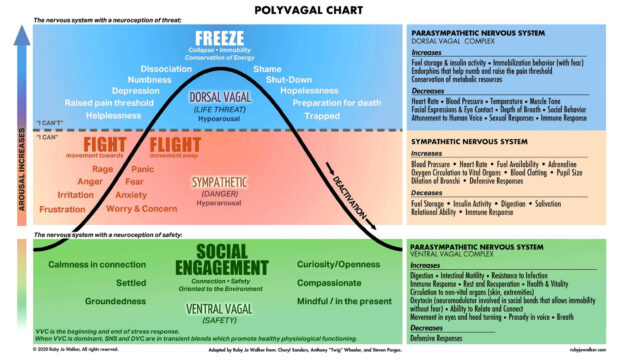EMDR & Neurodiversity
What is EMDR?
EMDR addresses traumatic memories and connects them with adaptive thoughts which improves nervous system regulation.
Shapiro’s (2001) Adaptive Information Processing model posits that EMDR therapy facilitates the accessing and processing of traumatic memories and other adverse life experience to bring these to an adaptive resolution. After successful treatment with EMDR therapy, affective distress is relieved, negative beliefs are reformulated, and physiological arousal is reduced.
Copied from: https://www.emdr.com/what-is-emdr/
Polyvagal Theory
Below is a chart of nervous system escalation. Polyvagal Theory summarizes this. Individuls who have experienced chronic traumatic events (i.e., bullied, sensory overwhelm) remain escalated in the red and blue zones, which is maladaptive and can cause significant long term consequences. EMDR assists in regulating the nervous system.
- Here is more information on Polyvagal Theory.
- Please research Dr. Stephen Porges for additional information.

EMDR with Neurodiverse Clients
Our focus is providing EMDR to neurodiverse clients (i.e., autism, ADHD, sensory processing, etc.).
- Sensory Processing
- Here is a video on trauma due to sensory overstimulation.
- Autism
- Here is a study of EMDR with autistic clients.
- Here is another study of EMDR with autistic clients.
- ADHD
- Here an an article of EMDR with ADHD clients.
- Here is another article on EMDR with ADHD clients.
- Article: ADHD and Trauma: Untangling Causes, Symptoms & Treatments
PTSD prevalence in clinical samples of autistic individuals is estimated to be between 2% and 17%, compared to 3% in neurotypical individuals (Rumball, 2019). However, clinicians do not always screen for, and treat, trauma-related symptoms in autistic individuals (Kerns et al., 2020), so this may be an underestimate. Several risk factors increase vulnerability for PTSD development in autistic individuals (Peterson et al., 2019). These include increased exposure to traumatic events (e.g. victimisation, maltreatment, bullying), and regularly experiencing events that constitute ‘small traumas’ (i.e. events that are traumatic for the individual, but do not meet stringent diagnostic definitions of a traumatic event; Shapiro, 2018). It is also possible that, for some autistic individuals, there is an atypicality (or potentially, an autism-specificity) in terms of events construed as traumatic (Kerns et al., 2015; Rumball et al., 2020), for example, relating to changes to routines, rule-breaking of others, difficulties in making sense of events and sensory processing difficulties.
Autism. 2023 Jan; 27(1): 43–53.
Published online 2022 Apr 6. doi: 10.1177/13623613221080254
PMCID: PMC9806468
PMID: 35384753
Using EMDR with autistic individuals: A Delphi survey with EMDR therapists
Naomi Fisher,1 Caroline van Diest,2 Marguerite Leoni,3 and Debbie Spain3
Please Note: We have completed EMDR basic training. We are in supervision. We are not certified providers of EMDR at this stage of our training. We are providing EMDR to our current clients while being supervised.
- The EMDR International Association has a list of certified providers (with higher levels of training). Here is their therapist directory.
- Here is a list of EMDR providers from Psychology Today.

